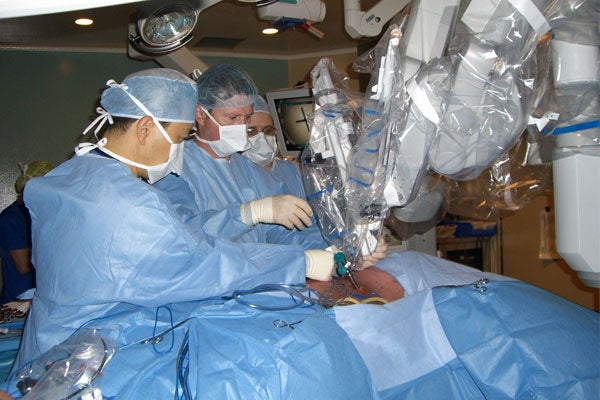
Canadian first: Early-stage lung cancer gets new surgical treatment with robot
Published: March 2, 2012
In a Canadian first, a robotic surgical system has been used to treat early-stage lung cancer by removing the cancer, along with a lobe of the lung.
The pioneering surgery was performed at the University Health Network's Toronto General Hospital by a team of surgeons led by two University of Toronto professors in the Faculty of Medicine’s Department of Surgery – Dr. Kazuhiro Yasufuku, director of the Interventional Thoracic Surgical Program at Toronto General Hospital (TGH), and Dr. Tom Waddell, thoracic surgeon and head of the Division of Thoracic Surgery.
The team performed a robotic surgery on a 78-year-old man with a tumour the size of a penny in his lung’s upper right lobe. After examining the images of the tumour and its location and assessing the potential benefit to the patient, the team decided that the best option for the patient was to use the da Vinci Surgical System to remove the cancerous portion of the lung.
Physicians say the use of the robotic system improves outcomes after surgery and will expand the number of patients who can benefit from this type of minimally invasive surgical treatment.
“More than 70 percent of lung cancers have a good chance of being cured if they are treated early enough, so we have brought together a team of surgeon-scientists to use and further develop the latest technology to try to change lung cancer’s horrible statistics, “ said Yasufuku.
He said the future of treatment belongs to robotics since it can incorporate different imaging modalities, which will guide surgeons to perform surgery more safely, and possibly more precisely, something that is not possible with other techniques.
Yasufuku, one of the most internationally respected thoracic surgeons with expertise in minimally invasive thoracic surgery and diagnostic procedures, was recruited from Tokyo, Japan to set up a unique interventional thoracic surgical program at TGH, which includes the development of novel technology and a surgical suite to improve the current ways of diagnosing and treating lung cancer.
Lung cancer remains the leading cause of cancer death for both men and women. More than 25,000 Canadians are diagnosed with lung cancer yearly, and more than 20,000 will die of it.
On average, 69 Canadians will be diagnosed with cancer every day, and on average, 56 Canadians will die of lung cancer every day. One in 11 men is expected to develop lung cancer during his lifetime, and one in 13 will die of it. One in 15 women is expected to develop lung cancer during her lifetime, and one in 17 is expected to die of it.
The day after his robotic surgery, Stanley Skorpid, 78, was able to get out of bed and eat cornflakes for breakfast. On the third day,Skorpid was impatiently walking the hospital hallways, and on the fifth day, he was glad to be going home. He is now back at work as a concierge and remains cancer-free.
“I’m still here,” he said happily. “I’m feeling good.”
Many centres would not consider surgery for someone of Skorpid’s age, pointed Dr. Yasufuku, noting that the use of the robotic system contributed to Skorpid’s early recovery, along with minimal complications and pain and a better quality of life.
Surgeons at TGH have since performed six more successful surgeries with the robotic technique on patients with lung cancer. The patients typically have shorter hospital stays, less pain, easier recoveries, less blood loss and scarring than if they had been operated on with open-incision surgery.
During Skorpid’s surgery, the surgeons made four tiny incisions in his chest between the ribs to insert a small scope and thin robotic-assisted surgical instruments. The scope provides a three-dimensional view of the chest and lungs on high-definition monitors – a magnification 10 times greater than normal vision -- while the surgical tools are used to remove the cancer.
The surgeon’s hands control the four robotic arms from a nearby console, and the robotic arms, in turn, translate the surgeon’s hand movements into smaller, flexible, and more precise movements of tiny instruments inside the body in real time. This precision and flexibility is especially useful in dissecting and then removing tumours, as well as clearing the small bean-shaped lymph nodes located along the system of lymphatic vessels, around large blood vessels; in minimizing damage to the chest wall and surrounding tissues; and in meticulously being able to remove the smallest possible portion of the cancerous lung.
Traditionally, lung cancer resections have been done via an open incision or thoracotomy. This means that the ribs are spread apart to provide access to the chest, and this spreading of ribs and cutting of the muscle is linked to discomfort after surgery.
Moreover, patients are left with a long incision on the side of the chest and a long recovery after the operation. Sometimes, minimally invasive thoracoscopic techniques are used instead, but they are limited by a standard video monitor and rigid instruments.
The da Vinci System enhances the surgeon’s technique and capability in performing complex minimally invasive surgery, such as in fine-tissue dissection and suturing. Named after Leonardo da Vinci who invented the first robot and used anatomical accuracy and three-dimensional details to give life to his masterpieces, the system provides surgeons with similarly enhanced details.
“The robot becomes your hands, it augments what your hands can do,” explained Yasufuku. “It’s so easy for your hands to move much more finely right inside the patient. They can get in really deep.”



